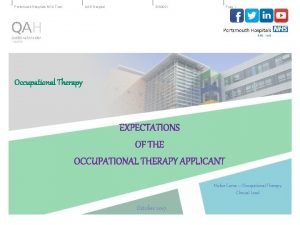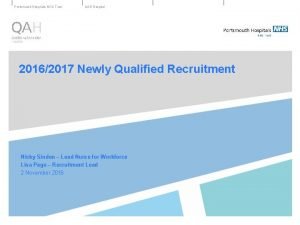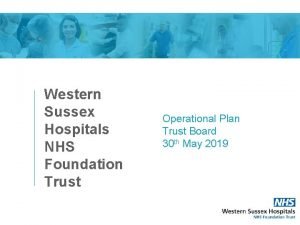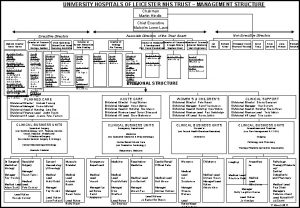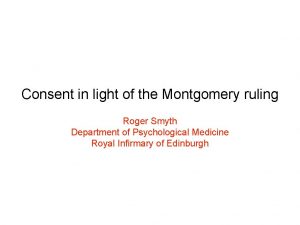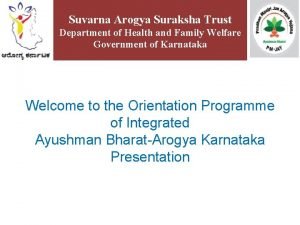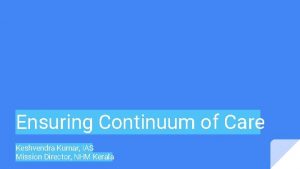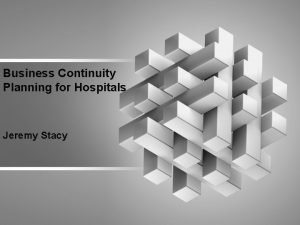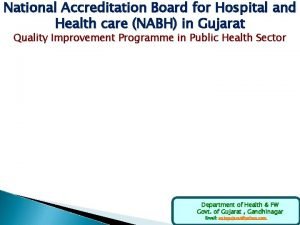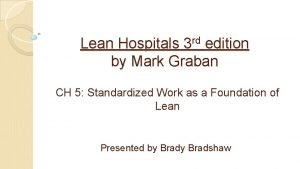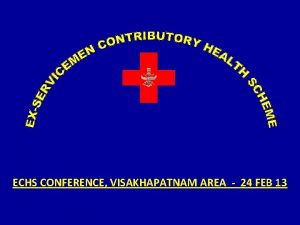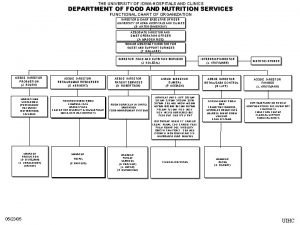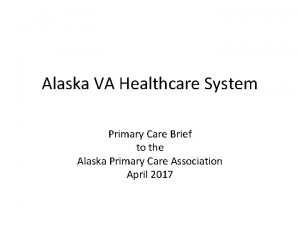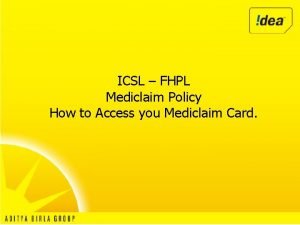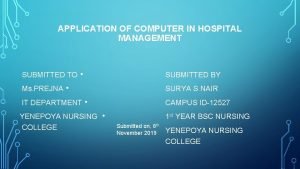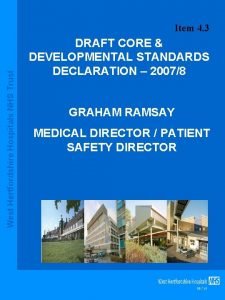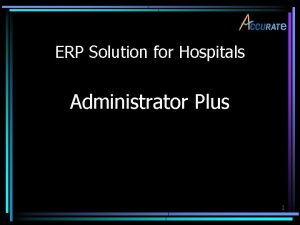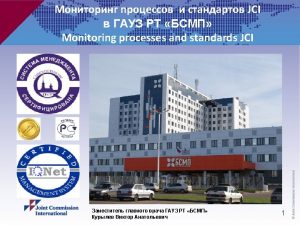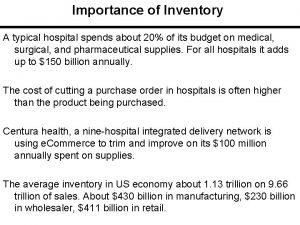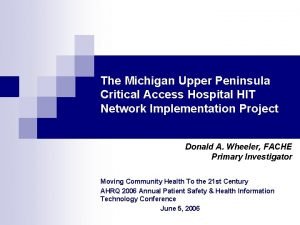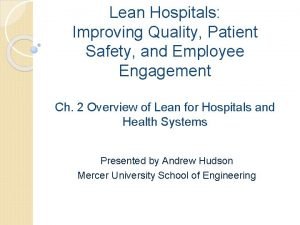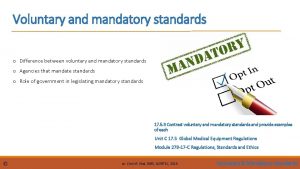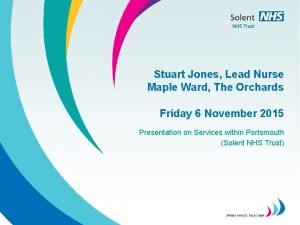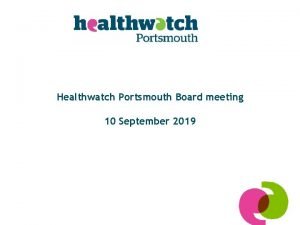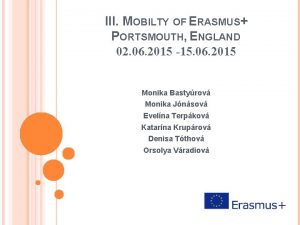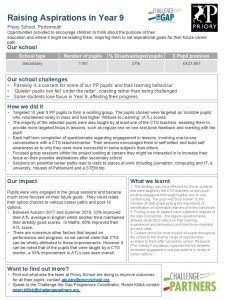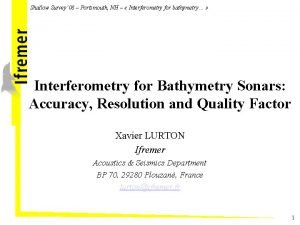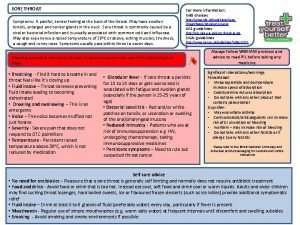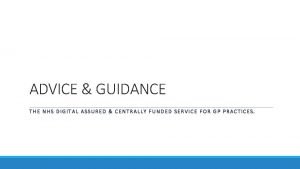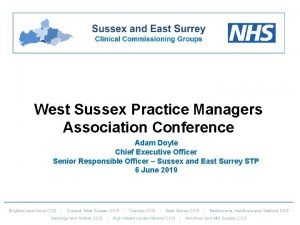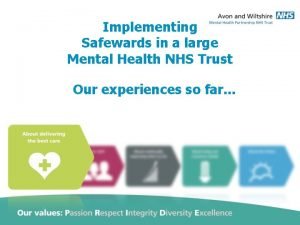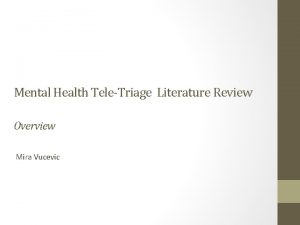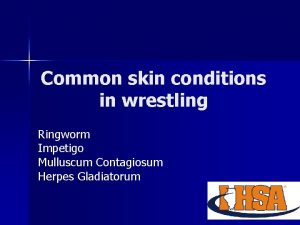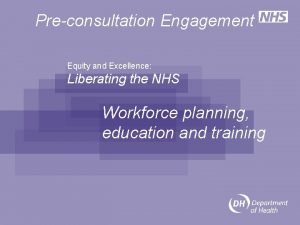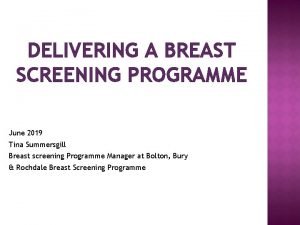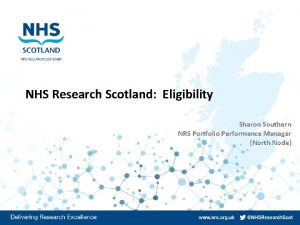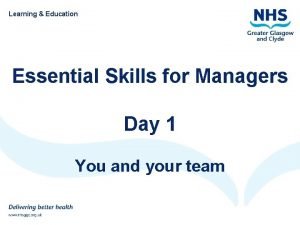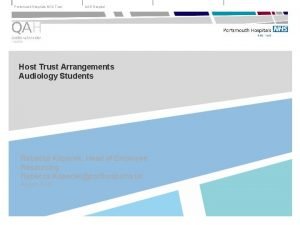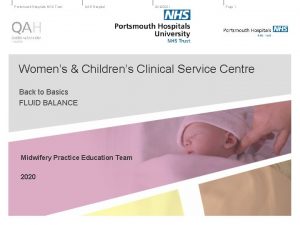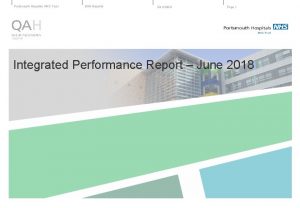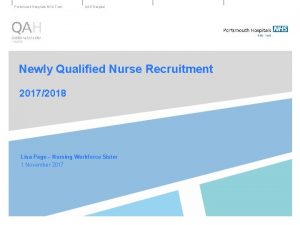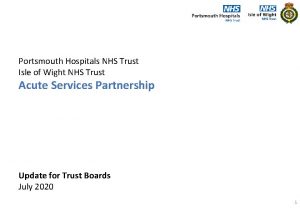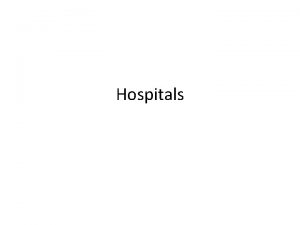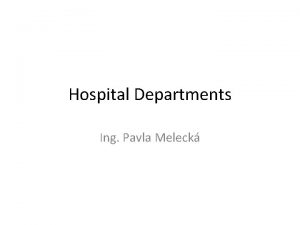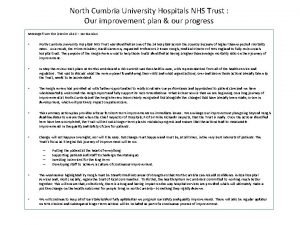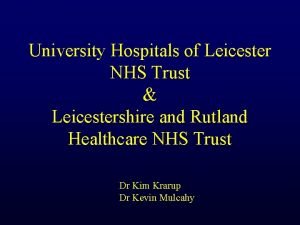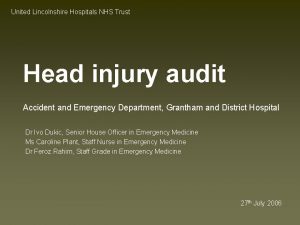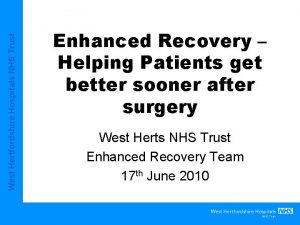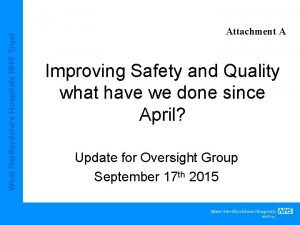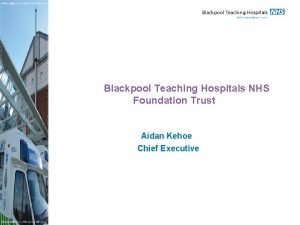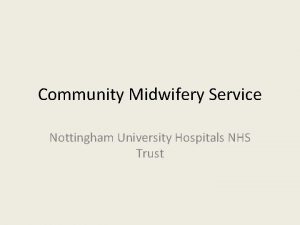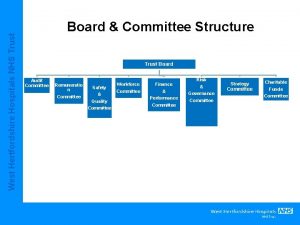Portsmouth Hospitals NHS Trust QAH Hospital 17062021 Page




























































- Slides: 60

Portsmouth Hospitals NHS Trust QAH Hospital 17/06/2021 Page 1 Integrated Performance Report – June 2016

Portsmouth Hospitals NHS Trust QAH Hospital 17/06/2021 Page 2 Contents Section Page 1 Performance Outcomes 3 2 Quality Performance 5 3 Operational Performance 34 4 Financial Performance 49 5 Contractual Performance 50 6 Workforce Performance 52 7 Key 60

Portsmouth Hospitals NHS Trust QAH Hospital 17/06/2021 Page 3 Enablers – Performance Outcomes Integrated Performance Outcomes – June 2016 • The quality position remains stable, with a significant improvement being seen in the response rates and positive response for the Friends and Family Test and the a reduction in number of times patients are moved between 0001 and 0700. There has, however, been one Never Event reported in June. This concerned insulin administration using the incorrect device. The incident has been thoroughly investigated and there was no harm to the patient. • A&E performance improved during June and the Trust achieved more than 85% performance against the 4 hr standard on 10 days and achieved 85. 12% in the week ending 19 th June. Overall performance for the month was 81. 98% against an improvement trajectory of 76. 7%. This was achieved despite continued high demand with an average of 303 type 1 attendances per day (comparable with June last year) despite the direct admission of GP heralded patients and an average of 194 medically fit for discharge patients occupying beds on a daily basis. Average occupancy was 96. 3% and there were an average of 28 escalation beds open and a maximum of 46. The key area for further improvement is delivery of the ward standards and discharge targets set by CSCs in their ‘Safer’ bundles. This will require an improvement in the number of ‘simple’ discharges achieved by clinical teams at PHT and an increase in the number of complex discharges health and social care organisations are able to support, particularly at week ends. • Continued capacity constraints and the cancellation of some weekend lists impacted on the Trusts ability to deliver the 18 week standard and the trust achieved 91. 9% despite treating 535 (8%) more elective patients than in June last year, and the number of patients waiting more than 35 wks for treatment has continued to improve There were 70 on the day cancellations but no breaches of the 28 day guarantee. The diagnostic 6 wk standard was achieved as per improvement and sustainability trajectory. • The Trust is forecasting achievement of 5 of the 8 national cancer standards, provisionally, 62 day and 31 day first definitive treatment, and 2 wk. breast symptomatic have not been achieved. All are expected to improve once validation and capture of all treatments is completed. Provisionally 11 patients were treated outside the 104 day maximum wait standard. • Overall Sentinel Stroke National Audit Programme (SSNAP) performance has improved from level D to level C due to improvement in therapy responsiveness, multidisciplinary working and discharge planning. • The 2016 17 Income and Expenditure annual plan delivers a £ 1. 2 m surplus. The Trust's I&E position at the end of Month 3 was an actual deficit of £ 4. 8 m, this is in line with plan at this time. The month 3 income position has been reported at planned levels for most points of delivery where activity information was not readily available. Cost Improvement Savings of £ 3. 2 m have been recorded for the year to date against a plan level of £ 2. 4 m. The Trust has spent £ 1. 9 m of capital against a programme for the year of £ 18. 5 m. The Trust had a cash balance of £ 2. 5 m at the end of June which was aligned to the minimum level of cash holding expected of 2 days. Currently the Trust has drawn down £ 31. 2 m of its working capital facility. • The temporary workforce capacity increased by 45 FTE and total workforce capacity increased by 52 FTE in June. The sickness absence rate in month has improved and decreased to 3. 6%. There is a big drive towards improving the trusts appraisal compliance to bring it back up to 85%. Appraisal compliance decreased in month and currently records at 73. 4%. 1 referral received in June for whistleblowing in June.

Portsmouth Hospitals NHS Trust 17/06/2021 QAH Hospital Page 4 June performance Exceptions to note in performance Indicator April May June Falls (Moderate or severe harm – confirmed) Safe Monthly numbers subject to change as incidents are confirmed Medication 2 0 (2 x severe harm) 3 2 (2 x severe harm) 2 0 Monthly numbers subject to (1 x severe, (2 x moderate change as incidents are 2 x moderate harm) confirmed harm) Comment • • Reduction in total falls incidents reported of 198 compared to 229 in May. Current year to date position of 4 confirmed falls incidents, all severe harm. 4 x moderate harm incidents are yet to be confirmed. • Never Event reported concerning insulin administration with the incorrect device. The incident has been thoroughly investigated and there was no harm to the patient. Current year to date position of 5 confirmed medication incidents; 1 x severe harm and 4 x moderate harm incidents to be confirmed. Reduction in the number of SIRIs reported in June. The decrease is explained by the reduction in 12 hour DTA breaches reported. One Never Event reported; as noted above. Increase in the HSMR for the 12 months to March 2016, however; the rate remains within the confidence interval and is therefore, ‘within expected range’. • • HSMR SHMI 32 40 9 99. 46 98. 77 100. 64 (Feb. Jan ‘ 16) (Mar. Feb. ’ 16) (April March ’ 16) 107. 32 107. 11 (Oct. Sept. ’ 15) (Jan. Dec. ‘ 15) CQC – Integrated Care of Older People Not applicable National Cancer Patient Experience Survey Not applicable Patient moves (non clinical) after midnight Friends and Family Test Responsive Caring Effective SIRIs Well led Quality of Care – Executive Summary Quality of Care Key Exceptions 155 In-patient response 23. 7% rate ED response 16. 9% rate • • • Slight decrease in the SHMI for January to December 2015 ; the rate remains within the official control limits, although slightly above the National Average of 100. • The CQC have published the results of their thematic review into how well health and social care and support work services work together to meet the needs of older people, and how this affects people’s experiences of care. The Trust participated in the fieldwork for this review between October and December 2015. The MOPRS CSC have reviewed the findings and are working to ensure there is further joined up working across the local health economy. • • 123 82 23. 4% 32. 8% • • Survey published by Quality Health on 5 th July 2016. On a scale of zero (very poor) to 10 (very good) patients rated their care within the Trust as 8. 6, compared to 8. 7 nationally. • The number of non clinical moves after midnight decreased from 123 in May (average 4. 0 per day) to 82 in June (average 2. 8 per day). A decrease has also been seen in the number of reported non clinical moves between 2100 and midnight, from 183 (average 5. 9 per day) in May to 153 (average 5. 1 per day) in June. • • 14. 7% 27. 9% An overall improvement has been seen in response rate and positive responses.

Portsmouth Hospitals NHS Trust QAH Hospital 6/17/2021 17/06/2021 Safety - Overview Quality of Care Overview – June 2016 Page 5

Portsmouth Hospitals NHS Trust QAH Hospital 6/17/2021 17/06/2021 Safety - Overview Quality of Care Overview – June 2016 Page 6

Portsmouth Hospitals NHS Trust QAH Hospital 17/06/2021 Page 7 Pressure Ulcers (reporting only) June position Avoidable hospital acquired grade 3 and 4 pressure ulcers • The Trust confirmed 2 avoidable grade 3 pressure ulcers in June (1 x MSK and 1 x Head and Heck) and 0 (zero) grade 4 pressure ulcers. This is comparable to the 2 avoidable grade 3 and 0 grade 4 pressure ulcers reported in May. • The current year to date position is 8 avoidable grade 3 and 0 (zero) grade 4 pressure ulcers. Unavoidable hospital acquired pressure ulcers • The Trust confirmed 0 (zero) unavoidable grade 3 pressure ulcers in June. This compares to 10 unavoidable grade 3 pressure ulcers reported in May. Safe – Pressure Ulcers Grade 1 and 2 pressure ulcers • The Trust confirmed 3 x grade 1 and 2 x grade 2 pressure ulcers in June giving a total of 5. This compares to 13 reported in May (7 x grade 1 and 6 x grade 2). Actions and progress to date • The Medicine CSC will come out of intensive support as excellent progress has been made with their actions • The Tissue Viability Nurse team will start auditing effectiveness of the learning posters over the next 2 months • The ‘Purpose T Tool’* will be piloted on G 1 during July; this will include a comprehensive education Programme for the team. Present on admission • A total of 156 ‘present on admission’ pressure ulcers were reported in June compared to 161 in May. Per 1, 000 occupied bed days (OBD) • The data for June (based on all reported incidents resulting in moderate, severe or catastrophic harm) is demonstrating a rate of 1. 2 pressure ulcer incidents per 1, 000 occupied bed days, compared to 1. 6 in May. • From next month, reporting will be based on confirmed incidents and will; therefore, figures will be subject to change as incidents are confirmed. * A pressure ulcer risk assessment framework intended to identify adults at risk of pressure ulcer development. This tool will improve assessment and care of patients who are at risk of pressure damage. n. b: There are no columns on the graph for December due to zero numbers reported.

Portsmouth Hospitals NHS Trust 17/06/2021 QAH Hospital Page 8 Pressure ulcers – Skin bundle compliance (reporting only) June position Braden and SKIN Bundle compliance – June 2016 Month Safe – Pressure Ulcers • The compliance is set against the overall audit submission rates, which for June stands at 99%; equal to the submission rate for May. • Compliance with the SKIN bundle for June has decreased slightly to 94%, compared to 95% reported in May. Braden SKIN Bundle Submission rate June 94% 99% May 93% 95% 99% April 93% 94% 88% CSC Audit compliance – June 2016 Submission Braden Skin Bundle CHOC 100% ↔ 95% ↓ 95% ↔ Emergency Medicine 100% ↔ 85% ↑ 100% ↑ Head and Neck 100% ↔ 90% ↑ 88% ↓ Renal 100% ↑ 90% ↓ 100% ↔ Women and Children 100% ↔ Surgery 90% ↓ 98% ↑ 97% ↓ • Reminders are sent to all CSCs of the requirement to complete and submit compliance. MOPRS 100% ↔ 95% ↑ 92% ↑ MSK 100% ↑ 98% ↑ 100% ↑ Medicine 100% ↑ 98% ↑ 82% ↑ • Compliance continues to be monitored and discussed at the Executive Performance Reviews with each CSC. G 5 (private patient unit) 100% ↔ 85% ↓ CHAT 100% ↔ Trust total 99% ↔ 94% ↑ 94% ↓ • Compliance with Braden for June has increased slightly to 94%, compared to 93% reported in May. Actions and progress to date. CSC

Portsmouth Hospitals NHS Trust QAH Hospital 17/06/2021 Page 9 Falls (Quality Contract) June position Target: Monthly monitoring of incidents resulting in moderate, severe or catastrophic harm. • The Trust reported a total of 198 falls incidents in June; of which: 2 resulted in severe harm. Both of these incidents were reported within the Surgery and Cancer CSC. 52 resulted in low harm and 144 resulted in no harm. • The current year to date position is 4 x confirmed falls incidents resulting in severe harm and 4 x moderate harm incidents yet to be confirmed. Actions and progress to date • Falls prevention and management training continues to be provided across the Trust. • There is now an active Multidisciplinary falls strategy group in place. • A new quarterly poster to promote learning from previous falls incidents will be distributed across the Trust in July. • A Trust wide audit of falls prevention and post fall care will be trialed during July and August. Safe - Falls per 1, 000 occupied bed days Target: Quarterly rate of falls incidents resulting in moderate, severe or catastrophic harm per 1, 000 occupied bed days of 2. 0 on average each quarter. • The data for June (based on all reported incidents resulting in moderate, severe or catastrophic harm) is demonstrating a rate of 0. 1 falls incidents per 1, 000 occupied bed days which is comparable to the May figure. • From next month, reporting will be based on confirmed incidents and will; therefore, figures will be subject to change as incidents are confirmed. Total reported falls incidents – June 2016 CSC CHAT Clinical Support Services Emergency Medicine Head & Neck Medicine MOPRS MSK Renal & Transplant Services Surgery & Cancer Women and Children Grand Total None 3 0 5 4 51 31 14 6 28 2 144 Low 0 1 4 1 14 12 4 1 14 1 52 Level of harm Moderate 0 0 0 Severe 0 0 0 0 2 0 2

Portsmouth Hospitals NHS Trust QAH Hospital 17/06/2021 Page 10 Medication (Contract & Quality Account) June position Safe – Medication incidents Target: Monthly monitoring of incidents resulting in moderate, severe or catastrophic harm. • The Trust reported a total of 129 medication incidents in June; of which: 1 resulted in moderate harm within MOPRS. This incident is currently under investigation to be confirmed. 19 resulted in low harm and 109 resulted in no harm. • The current year to date position is 5 confirmed medication incidents; 1 x severe harm and 4 x moderate harm incidents yet to be confirmed. Actions and progress to date • Continue to actively encourage reporting and increase data quality, feedback and learning. A high level of no harm incidents across a CSC is indicative of a good safety culture. • A ‘Never Event’ concerning insulin administration with the incorrect device was reported in June. The incident has been thoroughly investigated and no harm was caused to the patient. • Storage of medicines and security is a current focus and the electronic key and swipecard access system is being investigated. New electronic patients own drug (POD) lockers are planned to be introduced on the renal unit to enable self medication and secure storage. Medication incidents per 1, 000 occupied bed days Target: Quarterly rate of medication incidents resulting in moderate, severe or catastrophic harm per 1, 000 occupied bed days of 0. 5 on average each quarter. • The data for June (based on all reported incidents resulting in moderate, severe or catastrophic harm) is demonstrating a rate of 0. 0 medication incidents per 1, 000 occupied bed days compared to 0. 3 in May. • From next month, reporting will be based on confirmed incidents and will; therefore, figures will be subject to change as incidents are confirmed. Medication incidents – June 2016 CSC CHAT Clinical Support Services Corporate Services Emergency Medicine Head & Neck Medicine MOPRS MSK Renal & Transplant Services Surgery & Cancer Women and Children Grand Total None 5 6 4 14 2 12 18 11 Level of harm Low Moderate 0 0 0 4 0 0 0 2 0 5 1 3 0 Severe 0 0 0 0 5 0 0 0 23 9 109 4 1 19 0 0 1 0 0 0

Portsmouth Hospitals NHS Trust QAH Hospital 17/06/2021 Page 11 Patient Safety Thermometer (Contract) June position Harm free care Target: Submit data to the National Patient Safety Thermometer • The Trust achieved 100% data collection for June. • To date the Trust has maintained high submission rates, with 100% being achieved each month. Actions and progress to date • Sustain 100% audit submission on all patients and validation of all Safe – Safety Thermometer harm events. Percentage of harm free care (contract) Target: Report percentage of harm free care. • In June, the Trust recorded in patient harm free care of 97. 8%; equal to the rate reported in May. This demonstrates a gradual increase in the percentage of patients receiving harm free care since January 2016. • The total harm free care, which includes pre hospital admission harm events, was recorded as 94. 4% in June which is an increase compared to the May rate of 92. 3%. • At 94. 4%, the Trust total harm free care is slightly above the national average of 94. 2%. (HSCIC June 2015 – June 2016. Official statistics published 6 th July 2016). Month Total Harm Free Care (data collection from number of patients) June 2016 94. 4% May 2016 92. 2% April 2016 93. 9% Types of harm Pressure ulcers Trust Harm Free Care 97. 8% (1, 077) 97. 8% (1, 075) 97. 7% (1, 096) April 2016 May 2016 June 2016 38 65 36 Falls 8 6 5 Catheter and UTI 18 12 12 VTE (new) 5 4 7 1, 096 1, 075 1, 077 (new and old) Total patients Actions and progress to date • Continued monthly reporting to the Director and Deputy Director of Nursing and Head of Nursing for each CSC with feedback to ward teams. • Specialist nurses working on education. • Clinical Dashboard available as a hard copy and via the intranet. • Service improvement work streams for all harm events. The Trust total harm free care rate is directly affected by these harm categories. An increase in numbers of these categories will result in a decrease in the rate of harm free care.

Portsmouth Hospitals NHS Trust QAH Hospital 17/06/2021 Page 12 Healthcare Acquired Infection (National) June position MRSA (Incidence more than 48 hours after admission) Target: 0 (zero) • The Trust reported 0 (zero) patients with MRSA bacteraemia attributed to the Trust in June. • The Trust’s year to date position is 0 (zero) cases, against an objective of 0 (zero) avoidable cases. C. Difficile (Incidence more than 72 hours from admission) Safety – Infection Control Target : 40 cases • The Trust reported 1 patient with C. Difficile attributed to the Trust in June against a monthly objective of 3. The case occurred within Medicine CSC. • The Trust’s year to date position is 6 cases against an objective of 10 (annual target of 40 cases). MSSA bacteraemia (Incidence more than 48 hours after admission) MSSA bacteraemia are not subject to DH trajectories, but are closely monitored by the Trust due to the high incidence of morbidity and mortality associated with these infections. • There were 5 patients reported with MSSA bacteraemia attributed to the Trust in June

Portsmouth Hospitals NHS Trust QAH Hospital 17/06/2021 Venous Thrombo embolism Screening (National) June position VTE Screening Target: 95% per month • The VTE risk assessment figure for June is 96. 6% (subject to validation); compared to 96. 8% recorded in May. • The National average for VTE assessment (NHS England, Q 4 2015 16) is 96%. VTE Appropriate prophylaxis Target: Monitoring and reporting • The VTE appropriate prophylaxis figure for June is 96. 1% (subject to validation); compared to the May figure of 97. 0%. VTE Serious Incidents Requiring Investigation (SIRIs) and Incidents Target: Monitoring and reporting Safe - VTE • There have been 0 reported VTE SIRIs in June • 84 VTE events were reported in June compared to 78 in May. Of these 26 were hospital associated events (HAT), compared to 23 in May and 58 were community associated events (CAT) compared with 55 in May. VTE Root Cause Analysis (RCA) Target: Monitoring and reporting • All VTE HAT events undergo RCA investigation (100%). Actions and progress to date • Sustain performance and actions from investigations. Page 13

Portsmouth Hospitals NHS Trust QAH Hospital 17/06/2021 Page 14 Serious Incidents Requiring Investigation (SIRIs) (Contract and National) June position SIRIs (including HCAIs and as reported on STEIS) Safe – Serious Incidents Target: Monitoring and reporting • 9 SIRIs were reported in June compared to 40 in May. This decrease is explained by the reduction of 12 hour DTA breaches reported. * To note, the 12 hour DTA breach occurred in May, but was reported to STEISS in June; hence being included. The total number of 12 hour DTA breaches for May stands at 34 and zero for June. SIRIs over 60 day deadline Target: Monitoring and reporting • There were 5 open SIRIs at the end of June which exceeded the target date of 60 working days for submission to the Commissioners. Extensions have not been agreed. Never Events Target: 0 (zero) • One Never Event was reported in June within the Women and Children’s CSC. • The incident involved an overdose of insulin administered via an incorrect device. The incident has been thoroughly investigated and no harm was caused to the patient. Duty of Candour The Trust is required to inform the patient and/or other relevant person within 10 operational days that the safety incident (moderate and severe harm) has occurred or is suspected to have occurred. • In June all patients, or their relatives where applicable, were informed of the incident within the deadline and are aware of the on going investigation. SIRI 12 hour Decision To Admit (DTA) Breach (x 1)* Missed diagnosis – PE related death (x 1) Grade 3 pressure damage (x 1) Hospital acquired C Difficile death (x 2) Fall resulting in fracture requiring surgical intervention (x 2) Overdose of Insulin administered via incorrect device (x 1) Never Event CSC Emergency Medicine Head and Neck MSK Surgery and Cancer Women and Children

Portsmouth Hospitals NHS Trust 17/06/2021 QAH Hospital Patient safety incidents (excluding SIRIs) (Contract) June position Safe - Incidents Target: Increase in overall reporting of low and no harm incidents and reduce severity of harm • At the time of reporting, the top three reported incidents for June were: Tissue damage: 308 incidents out of a total of 1, 484 (20. 6%) Pathology/Blood: 279 incidents out of a total of 1, 484 (18. 8%). These types of incidents have not previously been included within the top three themes. Further analysis has shown that this increase is due to a surge in cytology reporting issues; particularly relating to samples received from GP surgeries. Pathology are moving from local reporting systems to the use of the upgraded Datix, which has had a positive reporting effect. Clinical Event: 226 incidents out of a total of 1, 484 (15. 2%) • This compares with Tissue Damage, Clinical Event and Patient Accident/Falls in May. The reported pressure sores include present on admission from the community. • There were no reported incidents relating to admission, discharge or transfer resulting in moderate, severe harm or death. Actions and progress to date • Continue safety work streams to reduce avoidable harm. • Safety Learning Event reporting on the upgraded Datix Web system is now fully implemented. Implementation issues are still being resolved. • Training sessions continue; these are well attended Reported incidents at time of report Confirmed incidents at time of report June 2016 1, 484 N/A May 2016 1, 498 715 April 2016 1, 521 596 Month Page 15

Portsmouth Hospitals NHS Trust QAH Hospital 17/06/2021 Page 16 Patient safety incidents (Contract) • The ‘Total PHT reported Patient Safety Incidents June 14 – June 16’ graph represents the total number of all patient safety incidents reported by Trust staff (including community incidents). Safe - Incidents • There is a continued trend showing an increase in the number of reported incidents; a positive trend which aligns to the implementation of the upgraded Datix system incorporating the new simpler reporting form. • The second graph shows total confirmed incidents by severity for the month of May 2016. Severity is coded by the reviewing manager at close of investigation. As part of the Datix upgrade, from April 2016, all safety learning events are being checked for completeness and appropriate grading before being finally approved by the Risk Management team. • It should be noted that all incidents including SIRIs are graded on the severity of actual harm suffered by the patient. Definitions of harm: Severe : Any patient safety incident that appears to have resulted in permanent harm (directly related to the incident and not related to the natural course of the patient’s illness or underlying condition and defined as permanent lessening of bodily functions, sensory, motor, physiologic or intellectual, including removal of the wrong limb or organ, or brain damage) to one or more persons receiving NHS funded care. Moderate : Any patient safety incident that resulted in a moderate increase in treatment (defined as a return to surgery, an unplanned re admission, a prolonged episode of care, extra time in hospital or as an outpatient, cancelling of treatment, or transfer to another area such as intensive care as a result of the incident) and which caused significant but not permanent harm, to one or more persons receiving NHS funded care. Low: Any patient safety incident that required extra observation or minor treatment (defined as first aid, additional therapy, or additional medication) and caused minimal harm, to one or more persons receiving NHS funded care.

Portsmouth Hospitals NHS Trust QAH Hospital 17/06/2021 Page 17 Coroner’s recommendations and CAS alerts (Contract) June position Coroners recommendations – Regulation 28 reports (previously referred to as Rule 43 letters – to prevent future deaths) Target: Monitoring and reporting • The Trust received no Regulation 28 reports in June. CAS Alerts over deadline Target: Monitoring and reporting • 26 alerts were issued in June, none of which were applicable to the Trust. No alerts remain open for the Trust at the time of producing this report. • An automated system is in place sending weekly reminders of outstanding alerts to the Governance leads and e mail reminders sent to Carillion. Actions and progress to date Safe • Sustain positive action of CAS alerts.

Portsmouth Hospitals NHS Trust QAH Hospital 17/06/2021 Page 18 Effective – Sepsis (CQUIN 2016/2017) Sepsis (National CQUIN 2016/2017) CQUIN (Commissioning for Quality and Innovation) is a national quality incentive scheme which enables Commissioners to reward excellence, by linking a proportion of the providers' income to the achievement of quality improvement goals. Sepsis 2016/17 CQUIN criteria The sepsis CQUIN is on going for 2016/17 however; it has been extended to include in patients and an additional requirement of antibiotic review by day three. The quarter 1 audit is underway. The audit is resource intensive due to the volume of notes that need to be reviewed (at least 160 sets per month). There are challenges associated with the note review for in patients in the identification of confirmed sepsis. These new audit requirements and identified issues are being worked through. The quarter 1 audit will be submitted by 12 th August, in line with national reporting deadlines. The criteria for the CQUIN are as follows: a) Timely identification and treatment for sepsis in emergency departments i. A monthly audit of 50 sets of patients who presented to the ED and direct admit areas who were screened for sepsis ii. A monthly audit of 30 sets of patients who presented to the ED and direct admit areas with severe sepsis, Red Flag Sepsis or Septic Shock (as identified retrospectively via case note review of patients with clinical codes for sepsis) and who; a) Received intravenous antibiotics within 1 hour of presenting AND b) Received an empiric antibiotic review day 3 of them being prescribed b) Timely identification and treatment for sepsis in acute inpatient settings i. A monthly audit of 50 sets of patients whereby the patient is newly admitted, or is an existing inpatient, and was screened for sepsis ii. A monthly audit of 30 sets of patients whereby the patient is newly admitted, or is an existing inpatient, for whom a decision to treat with intravenous antibiotics, or to change the type of antibiotics previously prescribed, is made by a competent decision maker, and who; a) Receive intravenous antibiotics within 60 minutes (newly admitted)/90 minutes (existing inpatient) of the possibility that the patient has Red Flag Sepsis or Septic Shock AND b) Receive an empiric antibiotic review by day 3 of them being prescribed

Portsmouth Hospitals NHS Trust QAH Hospital 17/06/2021 Page 19 Antimicrobial Resistance and Stewardship (National CQUIN 2016/2017) CQUIN (Commissioning for Quality and Innovation) is a national quality incentive scheme which enables Commissioners to reward excellence, by linking a proportion of the providers' income to the achievement of quality improvement goals. Effective – Antimicrobial (CQUIN 2016/2017) Antimicrobial Resistance and Stewardship Rationale for National CQUIN: • Antimicrobial resistance has risen over the last 40 years with inappropriate and overuse of antimicrobials being a key driver. The number of new classes of antimicrobials coming to the market has reduced in recent years and between 2010 and 2013, total antibiotic prescribing in England increased by 6%. This leaves the prospect of reduced treatment options when antimicrobials are life saving and standard surgical procedures could become riskier with widespread antimicrobial resistance. • This CQUIN aims to reduce total antibiotic consumption measured as defined daily doses (DDDs) per 1000 admissions as well as to obtain evidence of antibiotic review within 72 hours of commencing an antibiotic. The CQUIN has two parts, the first aimed at reducing total antibiotic consumption and certain broad spectrum antibiotics and the second focused on antimicrobial stewardship and ensuring antibiotic review within 72 hours. a) Reduction in antibiotic consumption per 1, 000 admissions by the end of quarter 4 as follows: i. Reduction of 1% or more in total antibiotic consumption against the baseline. ii. Reduction of 1% or more in carbapenem against the baseline. iii. Reduction of 1% or more in piperacillin tazobactam against the baseline. b) Empiric review of antibiotic prescriptions to determine whether reviewed within 72 hours. Target: empiric review performed for at least the following percentages of cases in the sample: Q 1: 25%. Q 2: 50%. Q 3: 75%. Q 4: 90%. i. Local audit of a minimum of 50 antibiotic prescriptions taken from a representative sample across sites and wards. June position: a) Antibiotic consumption data was submitted to Public Health England to meet the Quarter 1 deadline. b) Empiric review of antibiotic prescriptions: • A Trust wide audit of 1, 071 patients was undertaken during quarter 1 (during the period 20 th June to 1 st July). A total of 337 patients were on antibiotics; of which 225 (67%) were reviewed within 72 hours. • It has been agreed with Commissioners that from July a representative sample of 50 prescriptions, from different clinical areas, will be reviewed to establish whether a review was undertaken within 72 hours.

Portsmouth Hospitals NHS Trust QAH Hospital 17/06/2021 Page 20 Acute Kidney Injury (Contract & Quality Account) June position Acute Kidney Injury (AKI) Target: 90% (on average each quarter) compliance with reporting the 4 mandated data sets on discharge summaries. Reduction (from 2015/16) in hospital acquired stage 3 AKI (reviewed 6 monthly) • The Trust achieved 92% compliance with the mandated items on the discharge summary in June, which is an increase on the 88% achieved in April and 89% in May. • The Trust achieved an overall compliance rate of 90% in quarter 1, therefore, achieving the target. • The Trust is aiming to reduce the number of hospital acquired AKI (AKI Alerts triggered ≥ 48 hours after admission); this will be reviewed in September by comparing AKI episodes recorded during the 2015/2016 financial year. Effective – AKI • To make it easier to assess the severity of the acute kidney injuries, they are categorised into 3 stages of alerts depending how much the persons creatinine has increased from their baseline level. Stage 1 Alert: An increase in a persons creatine that is 1. 5 to 1. 9 times higher than their baseline. This is often called a “mild AKI”. Stage 2 Alert: Same applies as for stage 1 but the increase for a stage 2 alert must be 2. 0 to 2. 9 times higher than the persons baseline. Stage 2 AKI are more detrimental to a persons health than a stage 1. Stage 3 Alert: The increase for a stage 3 alert must be 3 times or more higher than the persons baseline. Stage 3 alerts are the most severe AKIs.

Portsmouth Hospitals NHS Trust QAH Hospital 17/06/2021 Page 21 Local CQUIN Local and specialised CQUINs: used as an incentive to ensure providers of specialised services offer continuous improvement in line with best practice, benchmarked utilisation, appropriate care and quality indicators. June position Effective – Local CQUIN Specialised 1: Armed Forces Covenant Specialised 2: Clinical Utilisation Review (CUR) Specialised 3: Dental Network Specialised 4: Dental Reporting Standards Specialised 5: Dental Reporting Standards Specialised 6 : Intravenous Immunoglobulin (Ivig) Local (Local 1): Capitated outcomes based incentivised contracts (COBIC) Local (Local B): Reducing potential unwarranted clinical activity Local (Local C): Implementing the Recommendations from the Paediatric Review Details • Assurance that Mo. D patients and families are not disadvantaged in any way. • Review and build data on inpatients to inform of delays / delayed discharges etc. • Involvement in the local dental Managed Clinical Network. • Improvement in recording of GDS on patient record. • Improvement of data to meet flex and freeze. • Recording of General Dental Practice Code of referrer. • Reporting data in line with flex and freeze. • All patients approved by panel & recorded on database • Attendance at IVig meetings. • Plan for change that supports the transformation agenda and leads to the delivery of the ambition of adopting population based incentivised contracts. • This builds upon the 2015/16 agreed schemes and focuses on actions required to reduced potential avoidable unwarranted clinical activity. • ADT proposed. • This incentives implementing the outcomes and recommendations of the Unscheduled Paediatric Care Services Review. Current status June 2016 (M 3 Q 1) • Agreed and plans are in place to achieve. • Contract agreed and project team are in place. • Agreed and plans are in place to achieve. • Agreed and plans in place to achieve. • First stage achieved, Discussions under way with CCG & Solent to form next stage plan. • Agreed and plans are in place to achieve. • ADT to be finalised. • Mostly agreed. Awaiting Commissioner response.

Portsmouth Hospitals NHS Trust QAH Hospital 17/06/2021 Page 22 Mortality indicators: HSMR and SHMI (Contract and Quality Account) June position HSMR: April 2015 – March 2016 Hospital Standardised Mortality Ratio (HSMR) HSMR: 100. 64 (within expected range) Target: To be within expected range. • The Trust HSMR for the 12 months to March 2016 is 100. 64. This represents an increase on the rate previously reported for the 12 months to February 2016 of 98. 77. • The HSMR remains within the confidence interval of 95. 94 – 105. 51 and is therefore, ‘within expected range’ although slightly above the nominal national average of 100. Effective - Mortality • The weekday and weekend HSMR for emergency admissions are both ‘within expected range’. • The Clinical Effectiveness and Mortality Steering Group (CEMSG) continues to investigate any potential anomalies which appear. Feedback from recent coding audits has shown there to be no inconsistencies or causes for concern within coding. Summary Hospital-level Mortality Indicator (SHMI) Target: To be within expected range. • The Trust SHMI for January to December 2015 is 107. 11; which is an slight decrease from the previous quarter’s figures of 107. 32. • The SHMI remains within the official control limits, although slightly above the National Average of 100. • CEMSG continues to investigate some of the issues surrounding this with the benchmarking provider, Dr Foster. HSMR: Emergency weekday and weekend (Split based on patient admission date) April 2015 – March 2016 Weekday HSMR: 100. 00 (within expected range) Weekend HSMR: 102. 91 (within expected range) SHMI: January – December 2015 SHMI: 107. 11 (within expected range) Adjusted for palliative care: 106. 88 (within expected range) In hospital deaths: 105. 51 (within expected range) HSMR for the same period: 103. 49 (within expected range) Definitions: HSMR: The Hospital Standardised Mortality Ratio (HSMR) is an indicator of healthcare quality that measures whether the mortality rate at a hospital is higher or lower would be expected. The national average is 100 and a score of below this indicates less deaths than this average. HSMR covers 56 groups of diagnosis and only relates to patients that have died whilst in hospital. SHMI: The Summary Hospital-level Mortality Indicator (SHMI) is a high level mortality indicator that is published by the Department of Health on a quarterly basis. It follows a similar principal than HSMR, however SHMI covers all diagnosis groups and relates to all patients that have died (whether the patient died whilst in hospital or not ). It does not take account of deprivation. SHMI adjusted for palliative care: The variables used in the method to calculate the expected number of deaths differ between the SHMI and the HSMR, for example, the HSMR includes an adjustment for palliative care whereas the SHMI does not. An adjustment/allowance is made to the indicator ‘SHMI adjusted for palliative care’ to allow for the number of expected deaths where palliative care is coded.

Portsmouth Hospitals NHS Trust QAH Hospital 17/06/2021 Page 23 Dementia (Contract) June position Step 1: Find, Assess, Investigate and refer* Dementia compliance Target: 90% on average over each quarter for the three steps. • There has been continued compliance with step 1 in June, with a recorded total of compliance 94. 5%, which is an increase on the 93. 7% recorded in May. • This equates to 427 patients having been assessed, from a maximum of 457 eligible patients and, is an increase compared to May. • Compliance remains above the required target. Step 2: Diagnostic assessment* Target: 90% on average over each quarter for the three steps. Caring – Dementia • 100% of all eligible patients (58 in total) received a diagnostic assessment. Step 3: Referred for further diagnostic advice* Target: 90% on average over each quarter for the three steps. • The Electronic Discharge Summary (EDS) includes a mandatory field to inform the GP of any patients who have had a positive diagnosis of dementia in order that the GP can complete further investigations if required. However, as EDS usage is currently variable across the CSCs, a spread sheet is kept of all patients who have a positive diagnosis of dementia to ensure a letter is generated and sent to the GP. * Definition of steps: Step 1 – Case finding: • The number of patients >75 admitted as an emergency who are reported as having a known diagnosis of dementia or clinical diagnosis of delirium, or who have been asked the dementia case finding question, excluding those for whom the case finding question cannot be completed for clinical reasons (e. g. coma). Step 2 - Assessment: • Number of above patients reported as having had a diagnostic assessment including investigations. Step 3 – Onward referral – under development: • Numbers of above patients who have a plan of care on discharge that is shared with general practice. April 2016 May 2016 June 2016 Step 1 94. 2% 93. 7% 94. 5% Step 2 100% Step 3 100%

Portsmouth Hospitals NHS Trust QAH Hospital 17/06/2021 Caring – Mixed Sex Accommodation (National) June position Non-clinically justified single sex accommodation breaches Target: 0 (zero) • There have been no non clinically justified single sex accommodation breaches in June. • The Trust year to date total is 0 (zero) non clinically justified single sex accommodation breaches. Facilities single sex accommodation breaches Target: Monitoring and reporting • There been 0 (zero) single sex accommodation breaches relating to facilities in June. • The Trust year to date total is 0 (zero) single sex accommodation breaches relating to facilities. Page 24

Portsmouth Hospitals NHS Trust QAH Hospital 17/06/2021 Page 25 Caring – CQC Integrated Care for Older People CQC Building bridges, breaking barriers integrated care for older people • The CQC have published the results of their thematic review into how well health and social care and support work services work together to meet the needs of older people, and how this affects people’s experiences of care. • The Trust participated in the fieldwork for this review between October and December 2015. • The MOPRS CSC have reviewed the findings and are working to ensure there is further joined up working across the local health economy. CQC key findings: • There were still many organisational barriers that made it difficult for services to identify older people who were at risk of deterioration or unplanned admission to hospital in a timely manner. This included a lack of consistency in the use of assessments and in the sharing of information. • Whilst some of the examples of joint working in the delivery of health and social care were substantial, many were often short term or reliant on partial or temporary funding and goodwill between different providers. They were not a mainstream part of the way in which services were planned or delivered around older people. • Widespread commitment to delivering integrated care and a belief that it is improving. However, local leaders struggle to translate this commitment into an understanding for staff about how services work for older people across a local area, and within organisations, and how to collectively provide integrated care. • Older people often had multiple care plans as a result of professionals not routinely linking together and sharing information. Widespread lack of knowledge among professionals of how care plans should be written and reviewed. • Lack of connection between services often resulted in older people and their families or carers needing to take responsibility for navigating complex local services. • Older people and their families or carers were not routinely provided with clear information about how their health and social care would be coordinated, in particular in the event of unplanned or emergency admission to hospital or changes in their circumstances. Overall, substantial progress is still needed to achieve the collective ambition for integrated care across England. CQC Key recommendations: • Health and social care leaders build on the opportunities offered by the NHS Five Year Forward View vanguards etc. to develop and agree a shared understanding and definition of what integrated care means for their population in their local area, and work towards delivering this shared aim. • NHS England the Association of Directors of Adult Social Services lead on developing an agreed methodology at a national and local level across health and social care for identifying people who are at risk of admission to secondary care or deterioration, underpinned by a clear data set. • Commissioners and providers involve older people in making informed decisions about their care needs and care planning, in particular about the outcomes that are important to them, based on the existing national and local guidance. • Commissioners and providers in an area ensure that information and support for older people and their families or carers is available and that this sets out details of what services are available, connections between different services, and how the people’s accessibility requirements will be met. • The National Quality Board, in partnership with the National Information Board, develop and share a set of validated data metrics and outcomes measures for integrated care.

Portsmouth Hospitals NHS Trust QAH Hospital 17/06/2021 Page 26 Caring – National Cancer Pt. Exp. Survey National Cancer Patient Experience Survey 2015 • The Annual National Cancer Patient Experience Survey was published by Quality Health on 5 th July 2016. A total of 148 Trust’s participated. • 787 people were invited to participate in the survey during September to November 2015. A total of 571 questionnaires were returned; providing a response rate of 73% against a national response rate of 66%. This compares to 72% for both Southampton General Hospital and Poole (Dorset Cancer Centre). • On a scale of zero (very poor) to 10 (very good) patients rated their care within the Trust as 8. 6, compared to 8. 7 nationally. Key Headlines: • 94% of respondents said that hospital staff told them who to contact if they were worried about their condition or treatment after they left hospital. • 90% of respondents said that they were given the name of a Clinical Nurse Specialist (CNS) who would support them through their treatment. • 87% of respondents said that, overall they were always treated with dignity and respect when they were in Hospital. • 85% of respondents said it had been quite easy or very easy to contact their CNS. • 80% of respondents said they were definitely involved as much as they wanted to be in the decisions about their care and treatments. • 65% of respondents said that the GPs and Nurses at their General Practice definitely did everything they could to support them while the were having cancer treatment. Key Areas Identified from 2015 Results

Portsmouth Hospitals NHS Trust 17/06/2021 QAH Hospital Page 27 Complaints (Contract and National) June position No. of Complaints received Month Target: Monitoring and reporting Responsive - Complaints • A total of 71 complaints were received in June, an increase from the 55 received in May. • Reporting per 1, 000 contacts is one month arrears; data for May equates to 0. 71. compared to 0. 93 in April. • To date 27 complaints received in May have been responded to within 30 working days and 11 remain on target. Variance year on year Variance month on month 2013/14 2014/15 2015/16 2016/17 June 50 60 42 71 ▲ 29 ▲ 16 May 64 58 44 55 ▲ 11 ▼ 16 CSC May-16 Jun-16 CHAT 0 2 CSS 2 2 DMOP 2 0 EMERGY 12 11 H&N 3 9 MED 17 14 MSK 6 8 RENTRA 0 1 S&C 8 15 W&C 5 9 TOTAL 55 71 May UPDATE - Complaints Sent within 30 working days 27 49% Sent after 30 working days 8 15% On going past 30 working days 9 16% On going still on target 11 20% Green (Low risk) 26 37% Yellow (Moderate risk) 42 59% Amber (High risk) 3 4% Red (Extreme risk) 0 0%

Portsmouth Hospitals NHS Trust 17/06/2021 QAH Hospital Complaints (Contract and National) June position Complaint acknowledgment rate (national requirement) Target: Monitoring and reporting Responsive - Complaints • 100% of complaints were acknowledged within the 3 working day target in June. Parliamentary Health Service Ombudsman (PHSO) (National requirement) Target: Monitoring and reporting • The Trust received 2 new notifications from the PHSO in June. Plaudits Target: Monitoring and reporting • The Trust received 822 messages of appreciation during June. 2014 -15 Total rec'd 16 2015 -16 14 4 2016 -17 6 5 PHSO Under Part Upheld review upheld 0 3 9 0 1 1 Not upheld 4 9 Page 28

Portsmouth Hospitals NHS Trust 17/06/2021 QAH Hospital Complaints, PALS (Contract) June position PALS contacts Target: Monitoring and reporting • 523 contacts were handled by PALS in June, a continued increase from 499 in May. Responsive– Complaints Types of contacts • 117 of contacts involved concerns about care and treatment. • 80 (68%) of which were resolved within 5 working days. Other types of contacts • 406 of the above contacts related to providing cover for Bereavement Service, Voluntary Services, problems with telephone lines not being answered, and giving directions and Health Information advice. PALS conversion to complaints Target: Monitoring and reporting • 1 case was converted to a formal complaint. Trust-wide themes – June 2016 Communication Complaints PALS Total 16 32 48 Aspects of clinical treatment 25 19 44 OP appt delay/cancellation 4 27 31 Admission, discharge, transfer 5 8 13 IP appt delay/cancellation 2 11 13 Page 29

Portsmouth Hospitals NHS Trust QAH Hospital 6/17/2021 17/06/2021 Page 30 Patient Moves June position Patient moves – April 2016 Target: <3 non-clinical moves after 2100 Responsive – Patient Moves • Work continues to be undertaken to limit the number of non clinical moves experienced by patients. Data is collected for moves between 2100 and midnight and after midnight. 2100 - 0000 Month 0001 - 0700 No. Average per day • The number of reported non clinical moves between 2100 and midnight decreased in June to 153 compared to 183 in May. This equates to an average of 5. 1 non clinical moves between 2100 and midnight per day. It is to be noted that the number of moves continue to be informed by the high level of medically fit for discharge patients that remain in acute beds and the requirement to create acute bed capacity. June ‘ 16 153 5. 1 82 2. 8 May ‘ 16 183 5. 9 123 4. 0 April ‘ 16 170 5. 7 155 5. 2 March ‘ 16 159 5. 1 135 4. 4 • A decrease has been seen in the number of non clinical moves after midnight to 82 (average 2. 8 per day) in June compared to 123 (average 4. 0 per day) in May. Feb. ’ 16 133 4. 6 88 3 Jan. ‘ 16 147 4. 7 96 3

Portsmouth Hospitals NHS Trust QAH Hospital 17/06/2021 Page 31 Friends and Family Test (FFT): Increasing response rate in In patient areas and ED (National) Well-Led – Friends and Family June position Target: Inpatient response rate target to be similar or above national average but not fall below 15%. ED response rate target to be 15% or statistically significant response rate Friends and Family Response rates Total response rate (responses / eligible patients) Month • The total number of responses for both ED and in patients has increased significantly from 3, 412 in May to 5, 505 in June ‘ 16 • ED has seen a significant increase in the number of responses from 14. 7% in May to 27. 9% in June following a targeted process change and staff engagement work program. This is above the national average of 12. 7% in May. • The In patient response rate has also significantly increased from 23. 4% in May to 32. 8% in June. This is above the national average of 24. 9% in May. Outpatient Department (OPD) • In June, there was an increase in the number of responses following focused work in improving engagement. Overall, the Trust continues to receive positive responses. Actions and progress to date • Continued sustainability measures to monitor responses. Comments: May ‘ 16 April ‘ 16 ED In-patient Target: 15% Target: not fall below 15% Trust National average 27. 9% 2719/9729 14. 7% 1523/10365 16. 9% 1551/9155 12. 7% 12. 9% Trust National average 32. 8% 2786/8489 23. 4% 1889/8071 23. 7% 1881/7943 24. 9% 24. 5%

Portsmouth Hospitals NHS Trust QAH Hospital 17/06/2021 Page 32 Friends and Family Test Improving positive responses in ED, In patient areas and maternity(National) June position Well-Led – Friends and Family Improving positive response Emergency Department: • There has been an increase in the reported satisfaction rate to 95%. This is significant in that nationally there is a trend that sees a decrease in the satisfaction when there is an increase in responses. The Trust continues to exceed the national benchmark of 85% in May. • The number of patients who wouldn’t recommend ED, decreased to 1. 7% in June. This remains significantly better than the national average of 8% in May. In-patient areas: • The reported satisfaction rate has increased to 95. 9%, significant as nationally there is a trend that sees a decrease in the satisfaction when there is an increase in responses. This aligns to the national average of 96% in May. • The number of patients who wouldn’t recommend in patient areas decreased to 0. 9% in June. This is below the national average of 2% in May. Maternity: • The number of positive responses in June has increased to 99. 05% and this continues to compare favorably against the national benchmark of 96%. This figure is an increase from May by 1. 25% Emergency Department - Improving positive responses Month % recommend (positive) National Trust average % not recommend (negative) Trust National average June ‘ 16 95% 1. 7% May ‘ 16 93. 9% 85% 2. 4% 8% April ‘ 16 94. 5% 86% 2. 1% 8% In-patient - Improving positive responses Month % recommend (positive) National Trust average % not recommend (negative) Trust National average June ‘ 16 95. 9% 0. 9% May ‘ 16 93. 9% 96% 1. 0% 2% April ‘ 16 96. 2% 96% 0. 6% 1% Maternity - Improving positive responses Month % recommend (positive) National Trust average % not recommend (negative) Trust June 16 99. 05% 0. 95% May 16 97. 8% 1. 02% April 16 99. 3% 96% 0. 05% National average 1%

Portsmouth Hospitals NHS Trust QAH Hospital 17/06/2021 Page 33 Friends and Family Test – Maternity (National) June position Maternity Friends and Family response rates Target: Response rate for question 2 to be similar or above the national average but not fall below 15%. Well-led – Friends and Family • Women are asked to complete a Friends and Family form at four points of contact and respond to four specific questions. Q. April 16 May 16 June 16 1. 5. 9% 3. 4% 4. 9% 2. 25. 1% 23. 7% 27. 7% 3. 27% 32. 7% 38. 9% 4. 12. 8% 4. 5% 24. 7% Rate 17. 4% 15. 4% 17. 5% • The national benchmark and therefore; contract requirement is based on question 2. • The target for question 2 of 15% response rate, continues to be met. There has also been an overall increase in response rates from 15. 4% in May to 17. 5% in June. Actions and progress to date: • The results continue to be circulated to all staff showing the response rates for all questions. • Clinical Team leaders are asked to encourage uptake within individual clinical areas to increase uptake by the women. • In order to try to improve uptake of question 1 the named midwife can now give out the questionnaire at 36 weeks of pregnancy. Response themes: The majority of responses are positive. Positive comments: • • • Everything was outstanding from start to finish. All of the staff were helpful and caring especially with breast feeding advice. My care was outstanding and me and my baby felt safe and looked after. Staff friendly and helpful. Extremely caring nature of staff. Bedside manner has been of a very high standard and supportive throughout. Negative comments: • Long time for discharge The discharge process on B 7 is currently being reviewed by clinical lead midwife for postnatal ward. • Long waits at Consultant clinics at QA and Gosport War Memorial Hospital Letter templates to be reviewed by the administrative team. Maternity Friends and Family questions Q 1. Antenatal care (community based care up to 36 weeks). Q 2. Intrapartum labour care. Q 3. Immediate postnatal care. Q 4. Postnatal care up to discharge to Health Visitors.

Portsmouth Hospitals NHS Trust QAH Hospital 17/06/2021 Page 34 Responsive – Operational Overview Performance Against TDA Accountability Framework – June

Portsmouth Hospitals NHS Trust QAH Hospital 17/06/2021 Page 35 Responsive – Operational Overview NHS Constitution performance key Standards June Referral to Treatment (RTT) Incomplete standard • This is all patients waiting for treatment (total waiting list) The Trust achieved 91. 9% against the 92% standard for June, just behind the improvement trajectory of 92% at aggregate level with speciality fails due to continued capacity issues. • There were no breaches of the 0 tolerance 52 wk. maximum wait standard. Diagnostic waits • The maximum 6 week waiting time standard for diagnostics was achieved, performance was 99. 4% against the improvement trajectory of 99. 1% (national standard 99%) A&E service quality standards • Performance was 81. 98% against the 95% standard and improvement trajectory of 76. 7% Total attendances in June averaged 392 per day compared to 400 per day in June last year despite the direct admission of GP heralded patients. • There were 0 breaches of the 12 hr trolley wait standard Cancer standards - Provisional • 5 of the 8 national standards were achieved. 31 day and 62 day first definitive treatment, and 2 wk. breast symptomatic are currently not being achieved, validation and capture of all treatments is expected to improve performance but the standards are unlikely to be achieved. • Provisionally there were 11 patients who waited more than 104 days for treatment. Cancelled operations • There were no breaches of the 0 tolerance 28 day guarantee. • 3 urgent operations were cancelled but none of these for a second time. Delayed Transfers of Care • 5. 1% of patients were officially delayed in their transfer of care which is compared to 0. 9% 3. 6 in June last year. Average number of medically fit for discharge patients in Trust beds was 194 per day (66 Portsmouth, 128 Hampshire, 6 out of area)

Portsmouth Hospitals NHS Trust QAH Hospital 17/06/2021 Page 36 Responsive – Contractual and local Contractual and Local Standards – June Performance Contractual and Local Standards Ambulance delays • 167 patients experienced an ambulance delay of more than 30 minutes, compared to 446 with last month. • 21 patients experienced a delay of more than 60 minutes compared to 183 last month. Stroke Care Provisional (see exception report) • These are now being reported using the Sentinel Stroke National Audit Programme Tool Kit and as a result will be available a month in arrears. Work is on going to provide year to date performance from the tool kit. • Provisional performance for May was that 49. 2% of stroke patients were admitted to the stroke unit within 4 hrs. • Performance against the 90% stay target was 74. 5% Admission Avoidance • These standards will be measured a month in arrears as requires activity to be coded. Emergency Angioplasty • Emergency angioplasty within 90 mins of arrival was achieved for 88. 5% of patients. (standard 80%) • Emergency angioplasty within 60 mins, performance was 80. 8% and achieved. (standard 70%) RTT Backlog and long waiters • It should be noted that patients waiting for a diagnostic as part of an 18 wk pathway are now included in the incomplete position. The overall waiting list size increased by 1, 353 and the backlog by 222 ( admitted backlog by 47 and non admitted by 175) • The number of patients waiting more than 35 weeks reduced to 121. Cancer 62 day consultant upgrade (provisional) • There were no eligible patients treated against this standard.

Portsmouth Hospitals NHS Trust QAH Hospital 6/17/2021 17/06/2021 Page 37 Exception Report : A&E waiting time standard performance Responsive – Unscheduled Care June performance against the 4 -hour A&E and 12 hr Trolley Wait standards. Performance against the 4 hr standard improved and was 81. 98%, compared to 79. 99% in May, and better than the improvement trajectory of 76. 7% There were 0 breaches of the 12 hr Trolley Wait Standard. Contributing factors • QA type 1 attendances 303 per day and comparable with June last year (302) despite direct admission of GP heralded patients. (graph 2) The conversion rate to admission was 33% (graph 3) • High numbers of medically fit patients waiting for packages of care and placement Actions and progress to date • Implementation has commenced of the completed project plans for the 8 key areas as part of the Unscheduled Care Improvement Plan (covering A &E, AMU, ambulatory care, medical take, short stay pathway, frailty intervention, ward discharge planning and ward discharges and the SAFER flow bundle and site operations. • An unselected general medical take model commenced on the 1 st June • The Short Stay Unit opened 1 st June with patients benefiting from a twice daily consultant review. • There has been a reduction in number and frequency of medical patients waiting in ED overnight for a bed on AMU from constantly more than 20 each night to less than 10 ensuring medical patients are receiving the right care in the right place on a more regular basis • Emergency department care spaces freed up, negating the need for patients to be cared for outside a dedicated Emergency Department care space • Working through Systems Resilience Board to increase discharge to assess capacity at home / in the community for acute elderly and medical patients to prevent admission and speed up discharge

Portsmouth Hospitals NHS Trust QAH Hospital 6/17/2021 17/06/2021 Page 38 Exception Report : A&E waiting time standard performance June performance 12 hr Trolley Wait standards. Responsive – Unscheduled Care There were no breaches of the 0 tolerance 12 hr trolley wait standard in June. Contributing factors • Type 1 attendances in June were 303 per day compared to 312 per day in May, Bed occupancy measure at the midnight bed state averaged 96. 3% compared to 98% in May. • The number of ambulance delays significantly reduced and the number of delays over 60 mins was 21 compared to 183 in May. • The Trust implemented the revised escalation policy and was able to manage all patients within the 12 hr standard. Actions, progress to date and risks • The revised ED Escalation Policy has been implemented. • The Urgent Care Improvement Plan is continuing to deliver improvements, reducing queues, reducing outliers and closing escalation areas so improving patient flow across the hospital and this month the new Short Stay Medical Unit was opened and a new model for managing the medical take was implemented. This will reduce the risk of any further patients having to wait longer the 12 hours.

Portsmouth Hospitals NHS Trust QAH Hospital 6/17/2021 17/06/2021 Page 39 Responsive – Unscheduled Care Exception Report : ED waiting time standard performance

Portsmouth Hospitals NHS Trust QAH Hospital 12/02/14 17/06/2021 Exception Report: Referral to Treatment (RTT) June Performance against Incomplete RTT standard • 91. 9% achieved against the 92% standard at aggregate level and an improvement trajectory of 92%. S England achieved 90. 5% for April. • The number of patients waiting more than 35 wks. improved from 132 to 121 at the end of June. The number waiting > 40 wks. was 38. • Patients waiting for a diagnostic on a RTT pathway have been included in the incomplete position as per national guidance and this has resulted in an overall increase in the waiting list size and the backlog. • There were no breaches of the 52 wk. maximum wait standard. Responsive - RTT Contributing factors • The trust delivered high levels of elective activity in June (535 8% more electives treated than June last year. ) but this was not sufficient to balance the increasing backlog in specialties with an underlying capacity shortfall. • Cancellation of additional weekend lists in early June • Changes in the medical rota to support emergency flow in cardiology reduced outpatient capacity, increasing waiting times. • Continued capacity shortfalls in urology, colorectal, gastro and hepatology contributed to the failure of the standard in these specialties. Actions, progress to date and risks • Detailed recovery plans have been agreed and implementation commenced for key areas at risk, General Surgery, Urology, Gastro and Hepatology. Cardiology rota has been addressed and the waiting time is starting to improve. • Scheduled assurance meeting reviewed to provide extended focus and support to specialties failing to achieve standard in a special measures approach. • Additional locums have supported delivery in urology, hepatology and gastro, with medinet providing weekend endoscopy lists. • Outsourcing is continuing. Page 40

Portsmouth Hospitals NHS Trust QAH Hospital 12/02/14 17/06/2021 Page 41 Exception Report: Referral to Treatment Improvement Plan Progress to date against Improvement trajectories • Recovery trajectory underpinned by speciality specific recovery plans including increased capacity and enhanced efficiency. • Trust on track to deliver overall performance inline with trajectory. • Internal special measures continues with specific focus on improvement plans and delivery of agreed trajectories. Urology 84. 4% stable but behind trajectory of 88. 5% • Overall capacity to treat both cancer and RTT patients remains key Responsive - RTT risk. Further surgeon has left, this has required careful management of patients with kidney stones to ensure no harm and maintain treatment with in 52 wks. including use of London providers, recruitment is on going. Continued prioritisation of cancer patients with additional weekly theatre sessions. Working to drive efficiencies to increase throughput. Remains a risk until substantive clinicians in post. General Surgery 87. 6% behind of trajectory of 89. 1% • Performance last month 88. 2%, reduced scoping capacity due to equipment failure has contributed to position, with limited additional capacity focused on maintaining caner waiting times. Gastroenterology 83. 8% against trajectory of 84% • Outpatient capacity is a key driver. ISTC have treated a small number of patients and additional external capacity secured and started in May treating an additional 48 patients per week. Other 91. 9% and ahead of improvement trajectory of 90. 9% • Outpatient capacity is a key driver, locum has been secured delivering an additional 8 sessions and there have been some virtual clinics which has reduced the number of patients waiting >35 wks. , but there remains a risk of 52 wk. breaches which is being carefully managed. Progress monitored at weekly special measures.

Portsmouth Hospitals NHS Trust QAH Hospital 12/02/14 17/06/2021 Page 42 Exception Report: RTT Patients waiting > 35, 40 and 52 wks. June performance against key waiting time metrics • There were no breaches of the 52 wk standard. . • There were 35 patients waiting > 40 wks. (34 last month) • There were 121 patients waiting >35 wks. (132 last month) Contributing factors • Underlying capacity issues in hepatology which account for 53 of the patients waiting more than 35 wks, and this started to improve (81 last month) with focused treatment of the long waiters with locum capacity. Responsive - RTT Actions and progress to date • The Trust is booking patients according to clinical priority and waiting time. • Hepatology is in special measures with additional weekly scrutiny and support provided by Director of Operations Scheduled Care. • A locum has been secured and is in place and providing additional outpatient capacity. Long waiters are being carefully managed to ensure that any additional tests required to progress treatment are fast tracked. • All patients over 40 weeks have treatment plans in place and are reviewed on a named patient basis at the weekly assurance meeting. • Work continues in hepatology, including pathway review and adherence to locally agreed referral management protocols to reduce demand. On-going Risks • Non admitted capacity constraints and difficultly in predicting whether attendance will stop • • the clock or pathway continue and as a result further long waiters. Continued cancellation of non urgent long waiting patients Capacity constraints in a number of specialties has been addressed by recruitment of clinical staff but these are not yet in post. Outsourcing capacity limited Specific risk for patients waiting for kidney stone removing which is being carefully managed by outsourcing as recruitment for a replacement surgeon is progressed. Maintaining the additional capacity provided by both locum and substantive staff during peak holiday period.

Portsmouth Hospitals NHS Trust QAH Hospital 12/02/14 17/06/2021 Page 43 Exception Report: Diagnostic 6 wk. referral to test standard June performance against the 6 wk. diagnostic standard Trust performance was 99. 4% achieving the 99% diagnostic standard and exceeding the improvement trajectory of 99. 1%. Contributing factors • Clinical capacity shortfall for non obstetric ultrasound has been addressed with careful management and private sector capacity. . • Clinical capacity shortfall for endoscopy has been addressed with weekend sessions provided by Medinet. Responsive - RTT Actions and progress to date • The contract with Medinet to provide weekend (Saturday and Sunday) all day sessions to provide additional scoping capacity to replace the shortfall caused by unplanned sickness of two endoscopists (one of whom has now left) and to reduce the backlog of surveillance patients past review date has been extended until September. Further options are also being explored. • Capacity at the ISTC is also being maximised, and there is locum capacity in place. • Non obstetric ultrasound has a national recruitment issue. The Trust has been unable to secure locums or substantive clinicians. Careful management of capacity continues to minimise delay in patients pathways and to maximise capacity. The Trust has secured capacity at a private provider to bridge the shortfall and recover the standard. • Short term solution in place for cardiology and work on going to agree permanent solution. Risks • Continued reliance on locum capacity to fill clinical gaps and therefore unstable and unsecure workforce. • High locum leave during August, work on going to mitigate risk and secure alternative capacity but likely that ISTC will also have reduced capacity due to leave. • Maintaining sufficient scope cleaning, due to equipment failure of outdated washers and water quality issues has resulted in last minute challenges and reorganisation of demand to mitigate risk. This risk has recently intensified due to identical risks with Gosport equipment.

Portsmouth Hospitals NHS Trust QAH Hospital 6/17/2021 17/06/2021 Page 44 Responsive – Cancelled operations Exception Report: Cancelled Operations 28 day Guarantee June Performance Cancelled Operations 28 day Guarantee • There were 3 urgent operations cancelled in June, but none of these were cancelled for a second time, and all have subsequently been treated. • There were no breaches of the 28 day zero tolerance standard, which applies to patients cancelled on the day of or after admission for non clinical reasons who have not been offered a binding date for surgery within the subsequent 28 days. • There were 70 patients cancelled on the day for non clinical reasons in June, all of whom were treated within the 28 day standard. Contributing factors • The Trust has continued to experience significant pressure due to unscheduled care demand which has included both medical and surgical patients, and this has meant that capacity has been carefully balanced and managed to ensure the overall safety of all patients which has led to last minute cancellation of procedures. • Due to the above pressures the Trust has continued to operate a reduced elective programme, with less patients booked and routine patients cancelled in advance where possible which has reduced the on the day cancellations and the risk of subsequent 28 day rule breaches. Actions, progress to date and risks • The Standard Operating Procedure for the management and escalation of on the day cancellations has been rewritten with clear escalation points and checklist and this was re launched in late January. • Weekly review of the patients at risk of 28 day breach is being strengthened to ensure that all previously cancelled patients are monitored until treated and contingency plans in place for those booked later than 14 days from original cancellation date. • These actions will minimise the number of breaches, but achievement remains a risk whilst emergency care pressures continue.

Portsmouth Hospitals NHS Trust QAH Hospital 6/17/2021 17/06/2021 Page 45 Responsive - Cancer Exception report: Cancer Standards (provisional position) June provisional performance against national cancer standards and contributing factors ( national reporting deadline 4 th August 2016 performance subject to change including additional shared breaches until submission deadline) • June very early provisional and unvalidated position, currently 5 of the 8 key standards have been achieved. • Performance is expected to improve once validation has been completed across all the standards, however treatments are low and the average breach tolerance has been exceeded. 62 days expected to improve but may not achieve the improvement trajectory of 84. 3%. • There were provisionally 11 patients who were treated in excess of 104 days (6 last month) – 3 respiratory (2 complex 1 delay unable to contact patient) 1 lower GI (patient choice) 4 urology (1 referred at day 65, 3 capacity) 2 dermatology (capacity) 1 head & neck (complex diagnostics) • This is monitored on a named patient basis at the weekly assurance meeting which also includes patients breaching the internal stretch targets of 61 days for 31 day standard patients and 92 days for all 62 day standard patients.

Portsmouth Hospitals NHS Trust QAH Hospital 6/17/2021 17/06/2021 Exception report: Cancer Standards continued June Performance 62 day first definitive treatment against recovery trajectory June provisional performance 76. 7% and expected to improve once validation and recording of all treatments has been completed but given the number of breached patients treated the standard will not be achieved. Responsive - Cancer Actions and progress to date • Urology, progress continues to be made in addressing the underlying clinical capacity shortfall, with additional lists and patient by patient management taking into account the clinical risk of any delay in treatment. This is being underpinned by pathway review including the long term management of surveillance patients to enable capacity to be focused to best clinical effect. As a result despite increasing demand the number of patients breaching standard improved. (see table) Speciality remains in special measures with very close monitoring of performance and delivery by Director of Operations (Scheduled Care) • Delivery of improvement plan on track and monitored at Cancer Steering Group, with weekly monitoring by Lead Cancer Manager and Director of Operations (Scheduled Care) • Weekly review of patients 14 days to breach on an individual basis to ensure treatment plan in place and delays mitigated where possible. On-going Risks • Capacity remains the key constraint, recruitment completed but will not be in place until September contingency plans are being developed. 2. 5 dermatologists have been recruited but capacity shortfall remains short term at busiest period of the year until clinicians in post. • Increase in proportion of fast track to routine referrals for dermatology • Locums have been secured to provide interim additional capacity to support pathways, but this has limited resilience as not substantive posts. • Planning for August bank holiday to ensure waiting times maintained has been completed. Page 46

Portsmouth Hospitals NHS Trust QAH Hospital 6/17/2021 17/06/2021 Page 47 Exception report: Cancer Standards continued 104 day maximum wait for treatment provisional Contributing factors and actions taken Responsive - Cancer • 11 breaches of the standard, 1 due to late referral, 3 complex pathways, 2 patient choice, 5 capacity. • Trust is working with the cancer network to review opportunities for sequential rather than serial diagnostics for complex pathways. • Trust has reviewed and strengthened RCA process and will be reviewing lessons learnt at the scheduled care assurance meeting. • Work continuing to increase capacity and ability to flex capacity to meet demand in Urology. • Patients reviewed on a named patient basis at weekly assurance meeting with action taken to expedite treatment.

Portsmouth Hospitals NHS Trust QAH Hospital 17/06/2021 Page 48 Exception Report: Stroke Contract Service Standards May Provisional Performance against key Sentinel Stroke National Audit Programme (SSNAP) using DIY analysis toolkit • The Trust provisionally achieved 6 of the 13 key measures for May (see table) Responsive – Stroke Care • • • based on 66 admissions (clock starts) Scan within 1 hr: improved but not achieved 39. 4% (standard 48%) Scan within 12 hrs: not achieved but improved 92. 4% (standard 95%) Direct Admission to Stroke Unit: improved but not achieved 49. 2% (standard 90%) Patients thrombolysed within 1 hr: not achieved 33. 3% (standard 55%) % patients who spend 90% of their stay on a Stroke Unit: not achieved 74. 5% (standard 80%) Speech and language assessment within 72 hrs: improved not achieved 83. 9% (standard 90%) Contributing factors • The on going unscheduled care pressures continue to have a direct impact on the ability to ring fence beds for acute Stroke patients, to directly transfer patients from ED and patient stays on the ward; the latter is compromised by the need to outlie patients in order to accommodate new Strokes. • Whilst Speech & Language performance continues to improve, gaps within the service provided by Solent means this remains difficult to sustain. Actions and progress to date • Focused work by the Stroke team within ED continues to lead to positive changes with direct admissions. • Continue to raise awareness of Stroke targets within ED and with Duty Hospital Managers/Operations Centre staff. • Working with SCAS and ED on implementing ‘straight to CT’ protocol for potential Thrombolysis patients to speed up door to needle times. • Solent have been asked to look at backfill arrangements to fill service gaps and support the team.

Portsmouth Hospitals NHS Trust QAH Hospital Enablers - Finance: Overview 17/06/2021 Page 49

Portsmouth Hospitals NHS Trust QAH Hospital 17/06/2021 Page 50 Enablers – Contract Performance Theme 16/7 Contracts Executive Summary –Financial values M 3

Portsmouth Hospitals NHS Trust QAH Hospital 17/06/2021 Page 51 16/17 Contracts Executive Summary – key exceptions to note 16/17 Contracts - Contract information is dependent on validation processes so this report is regarding Month 2 Enablers – Contract Performance Theme CCG. • STF trajectory plans are under way in Unscheduled care and Elective care as Service Development & Improvement Plans (SDIP). • • Progress against SDIPs requires close monitoring with Commissioners, the outcome of which is discussed at Contract meetings. A Contract Performance Notice (CPN) has been issued by CCGs for some incomplete actions in the CQC report which are not covered by current agreed plans. The Trust agreed additional actions have been added to existing plans (e. g. SDIP) by agreement, and therefore not to result in additional Remedial Action Plans. The CCG have introduced a revised PLCV policy and the Trust have brought some clinical risks and other ambiguities arising from the amendments to the attention of the Commissioners. Whilst these issues are resolved, this policy was implemented on 22 June it is still expected for the additional authorisation processes to apply. Failure to apply for correct authorisation will result in non payment. Some proposed QIPP aspirations have yet to be agreed in practice, and the Indicative Activity Plan (IAP) therefore still remains higher than Commissioners can afford. In some cases, the Trust is unable to deliver the full likely activity requirements without further plans for alternatives, and discussions are under way with other local partners to assist. The Trust continues to discuss some suggested changes in responsibility for mental health, learning difficulties, and other social needs services which were provided in the past by community partners during acute hospital stay. Local CQUIN agreement • A collaborative transformation project (COBIC) CQUIN scheme is agreed with Commissioners in outline, and the Trust is currently meeting with main Community partners in MSK to agree a way forward and a milestone plan in order to earn the full CQUIN Value. • The Trust continue to discuss aspects of the Paediatric unscheduled care strategy that can be implemented this year as part of the local CQUIN programme. • The CCG have proposed that we make improvements in Admission, Discharge and Transfer (ADT) processes as an additional CQUIN. The Trust is discussing with CCGs how this might work in practice, and may agree further work streams. NHS England contracts • The NHSE Contract is agreed and signed • A Contract Performance Notice has been received for delays in Pathology response times in Cervical Screening. A Remedial Action Plan is in place and agreed, expected to complete within 3 months without major concerns.

Portsmouth Hospitals NHS Trust QAH Hospital 17/06/2021 Page 52 Well Led – Workforce Performance Theme Workforce Executive Summary – key exceptions to note Performance Theme • The total workforce capacity increased by 52 FTE to 6, 865 FTE in June and is 35 FTE over the new funded establishment. • The temporary workforce capacity increased to 445 FTE in June, this is an in month increase of 38 FTE and comprises 6. 5% of the total workforce capacity. • Staffing levels (as per NQB Safe Staffing Levels) are reported as 102. 5% in June, this is a increase compared to May 16. • Appraisal compliance has decreased from 75. 2% to 73. 4% in June and continues to be below the 85% target. • Total essential skills increased in May from 87. 9% to 88. 5% in June and continues to record above the 85% target. • Information Governance Training has increased to at 86. 9% in June, however continues to be below the 95% target. • Fire Safety (face to face training) decreased to 69. 5% in June. • Sickness Absence Rate (12 month rolling average) slightly increased in month to 3. 6% in May and remains above the target. In month sickness absence decreased by 0. 3% to 3. 6% in May and is above the target. • 1 referrals received in June for whistleblowing and no referrals received for professional registrations or safeguarding.

Portsmouth Hospitals NHS Trust QAH Hospital 17/06/2021 Exception Report: Workforce Capacity Where we want to be: targets and benchmarks Target: Establishment of 6, 596 FTE, with target of substantive staff in post at 100% of establishment Safe – Workforce capacity Trends and Patterns • The funded establishment has increased by 42 FTE to 6830 FTE for June 16. The funded position excludes CIP and includes investments around anticipated activity growth and patient demand in 1617. • The total workforce capacity increased by 52 FTE to 6, 865 FTE in June and is 35 FTE over the new funded establishment. • Substantive workforce capacity increased by approximately 13 FTE in June to 6, 420 FTE • The temporary workforce capacity increased to 445 FTE in June, this is an in month increase of 38 FTE and comprises 6. 5% of the total workforce capacity. Root Cause analysis and insights • A significant temporary staffing resource is still required to fill existing vacancies across all areas. Workstreams are in place to switch off high cost temporary staffing and to recruit to these positions substantively. • Temporary staffing is being used to fill these vacancies as required. • Temporary staffing is also being used due to increased patient demand increased patient acuity, sickness and specialling. • Weekly monitoring and reporting of temp usage and the price caps for temporary workers continues and fortnightly meetings are held with each CSC to drive further reductions in temporary usage and overall pay bill where possible. Actions and progress to date • Recruitment will take place, targeting and providing a focus on the ‘hard to recruit’ areas to close the vacancy gap and drive reductions in the temporary workforce. Page 53

Portsmouth Hospitals NHS Trust QAH Hospital Safe Staffing Reports / NQB Where we want to be: targets and benchmarks SAFE Target: Planned staffing levels are 100%, planned skill mix 70. 4% RN: 29. 6% HCSW ratio Trends and Patterns The evidence collected for June indicates that overall staffing levels have increased from 100. 0% to 102. 5% compared to planned levels. The planned skill mix has decreased fractionally in June for Registered Nurses (RNs), and the actual skill mix for the Trust was 67% RNs with 33% Health Care Support Workers (HCSWs) which is a increase from May. Root Cause analysis and insights Funded establishment for the trust including nurses has been reset for new financial year. Actions and progress to date Recruitment continues locally, nationally and internationally, additional health care support workers are being used to supplement staffing numbers, and close working with NHSP continues to resolve any issues. 17 June 2021 Page 54

Portsmouth Hospitals NHS Trust QAH Hospital 17 June 2021 Page 55 Care Hours Per Patient Day Programme Where we want to be: targets and benchmarks Introduction To provide a single consistent way of recording and reporting deployment of staff working on inpatient wards/units, NHS Improvement have developed, tested and adopted Care Hours per Patient Day (CHPPD). CHPPD is calculated to by adding the hours of Registered Nurses (RNs) and Health Care Support Workers (HCSWs) per ward and dividing by the midnight bed occupancy figures for the ward. SAFE CHPPD reports split out RNs and HCSWs to ensure skill mix and care needs are met. Trends and Patterns • This is the second month reporting the CHPPD metric. • The evidence collected for May indicates that overall CHPPD is 5. 1 for RNs and 2. 5 for HCSWs for PHT. This was similarly reported in June.

Portsmouth Hospitals NHS Trust QAH Hospital 17/06/2021 Appraisal and Essential Skills Compliance Where we want to be: targets and benchmarks Target: The compliance target for Appraisals is 85% Trends and Patterns • Appraisal compliance has decreased and currently records at 73. 4% in June and Well Led – Appraisal and EST continues to be below the 85% target. The appraisal compliance has been below target since the beginning of the financial year. Root Cause analysis and insights • As of June, the 85% appraisal target has only been met by Women and Children. • CHAT, Emergency Care, Head and Neck, Medicine and Surgery and Cancer CSC have been below 80% for 4 consecutive months. Actions and progress to date • A targeted approach to address appraisal compliance has been adopted, which involves contacting the staff and managers of those who’s appraisal was most out of date. This approach has continued throughout June. Where we want to be: targets and benchmarks Target: the compliance target for Essential skills is 85% (Target for Information Governance is 95%) Trends and Patterns • Total essential skills increased in June from 87. 9% to 88. 5% and continues to record above the 85% target. • Essential skills compliance has increased in month for the majority of CSCs with the exception of Emergency, Medicine, MSK and Surgery and Cancer. Root Cause analysis and insights • Overall Safeguarding Children compliance (All Levels) is currently at 89. 2% and is above the 85% target. Level 2 has increased to 92. 6% and is above the 85% target. Level 3 continues to be below target and compliance currently records at 68. 6% and is a decrease compared to the previous month reported. • Fire Safety (face to face training) decreased to 69. 5% in June. • Information Governance Training has increased remained at 88. 5% Actions and progress to date • The L&D team are highlighting staff who are out of date with 3 or more essential skills. Chiefs of Service are being provided with regular information on Medical and Dental compliance to help meet the requirements of the CQC Action Plan. Page 56

Portsmouth Hospitals NHS Trust QAH Hospital 17/06/2021 Page 57 Workforce Capacity – Absence & Health and Wellbeing Safe – Absence and Wellbeing Where we want to be: targets and benchmarks Target: 3% Trends and Patterns • Sickness Absence Rate (12 month rolling average) increased to 3. 6% in May and remains above the target. In month sickness absence decreased from 3. 9% to 3. 6% in May and is above the target. Root Cause analysis and insights • CHAT, Emergency, MOPRS, MSK, Renal and Women and Children CSCs have the highest rate of in month sickness absence. • Some CSCs are above the in month 3% target in May with the exception of Surgery and Cancer, Head and Neck, Research and Development , Corporate Functions and Clinical Support CSC. • Emergency and Renal CSC above the in month target for May and has increased in month. Actions and progress to date • Absence management support continues to be provided to CSCs with high sickness absence by the HR team, with emphasis on the areas with the highest sickness. • Due to in month sickness slowly increasing over several months, letters have been sent out to managers to distribute to staff who have met the sickness absence triggers as per the sickness absence policy to drive sickness absence down and turn off temporary workforce where possible and necessary. Occupational Health and Safety Report Health and Safety • No RIDDOR incidents reported in June. • The number of sharps injuries reported in June recorded at 14. Predominately seen in CHAT and MOPRS CSC.

Portsmouth Hospitals NHS Trust QAH Hospital 17/06/2021 Page 58 Safe – Absence and Wellbeing Workforce Capacity – Absence & Health and Wellbeing CQUIN Health and Wellbeing – raising awareness of health and wellbeing CQUIN action plan has been sent to the CCG for approval which identified a number of actions. A number of events have been planned across the Trust to help improve the wellbeing of staff, in particular for sedentary workers. Health and Wellbeing Days • 3 members of occupational health staff attended Rodney road booked to see the outpatient services staff and the ICT staff. • Approximately 70 staff were seen and although it was very busy was interactive and productive. • A 'get to know your numbers' offering BP, Height, Weight, BMI, and Cholesterol checks was made. • A variety of leaflets were available ranging from lowering cholesterol to walking routes around Portsmouth A lot of focus was on promoting getting active with our main focus on walking as the majority of the work force are in sedentary roles. It was clearly expressed by the majority that they do sit at a desk from the start to end of their working day. • Average cholesterol readings of between 4 and 5, with the highest being 7. 6 (which shocked them but advice was provided to help them to understand the reasons) • All staff were encouraged to make a pledge and pin up on a board. The majority of pledges were to lose weight and get more active. On receipt staff were given some freebies water bottles, pedometers, stress balls, sticky note pads. • From the day 1 was referred to Fit for Work. Approx. 10 staff were encouraged to get there Blood pressures rechecked ideally at their GP practice. Wednesday 13 th July • 4 members of staff including mental health input went to Pharmacy distribution based at Hedge End. • Positively received by all staff and offered a 'get to know your numbers' offering BP, Height, Weight, BMI, and Cholesterol checks. Staff requested this to become an annual event. • Cholesterol readings for staff was successful. • General health promotion was provided and all staff were ask to make a pledge which everyone did again most pledges were to lose weight and get more active. Their manager has already set up a weekly weigh in programme which has had a good uptake. • Pharmacy Manufacturing has requested a day with them. CQUIN Flu • Promoted at team brief • Ideas Port to be used to get new ideas from staff • Matrons have been asked for more workplace vaccinators • Business case for charitable funds to be made

Portsmouth Hospitals NHS Trust QAH Hospital 17/06/2021 Workforce Governance Whistleblowing / Safeguarding / Professional Registration Well Led/Safe – Governance • 1 whistleblowing referral was reported in June, which the CSC is investigating. • No safeguarding referrals have been received or reported in June. • No Professional Registration referral was received and reported in June. Revalidation of Medical Staff • 8 doctors have undertaken revalidation as at 30 th June 2016. • 3 doctors have been deferred as at 30 th June 2016. • All medical staff are engaged in the validation process. Page 59

Portsmouth Hospitals NHS Trust Key QAH Hospital 17/06/2021 Page 60
 Portsmouth hospitals nhs trust jobs
Portsmouth hospitals nhs trust jobs Qah
Qah Western sussex hospitals nhs foundation trust board
Western sussex hospitals nhs foundation trust board Mededcoventry
Mededcoventry Uhl management structure
Uhl management structure Tasmin v barts health nhs trust
Tasmin v barts health nhs trust Airedale nhs trust v bland
Airedale nhs trust v bland Charitable work
Charitable work Suvarna arogya suraksha trust
Suvarna arogya suraksha trust Suvarna arogya suraksha trust
Suvarna arogya suraksha trust Apa powerpoint title page
Apa powerpoint title page Arogyakiranam
Arogyakiranam Bcp for hospitals
Bcp for hospitals National accreditation board for hospitals
National accreditation board for hospitals Graban lean hospitals download
Graban lean hospitals download Echs empanelled hospitals in visakhapatnam
Echs empanelled hospitals in visakhapatnam University of iowa hospital and clinics departments
University of iowa hospital and clinics departments University hospitals
University hospitals Anchorage va medical center
Anchorage va medical center Fhpl jaipur
Fhpl jaipur Application of computer in hospital pharmacy
Application of computer in hospital pharmacy Health standards section
Health standards section Lokmanya hospitals private limited
Lokmanya hospitals private limited Bed management in hospitals
Bed management in hospitals Strengths of hospitals
Strengths of hospitals Administrator plus hospital software
Administrator plus hospital software Niaho standards
Niaho standards Ipsg 1-6
Ipsg 1-6 2 bin inventory hospitals
2 bin inventory hospitals Mghs wheelers
Mghs wheelers Lean hospitals
Lean hospitals Difference between voluntary and mandatory standards
Difference between voluntary and mandatory standards Hospital pharmacy functions
Hospital pharmacy functions Adventure-trips in portsmouth
Adventure-trips in portsmouth Portsmouth nh
Portsmouth nh Icg portsmouth
Icg portsmouth Portsmouth safeguarding adults board
Portsmouth safeguarding adults board Pall corporation portsmouth
Pall corporation portsmouth Atomic mass average calculator
Atomic mass average calculator Treaty of portsmouth 1713
Treaty of portsmouth 1713 Stepping stones portsmouth ohio
Stepping stones portsmouth ohio Orchards portsmouth
Orchards portsmouth Arc rehab portsmouth healthwatch
Arc rehab portsmouth healthwatch Erasmus portsmouth
Erasmus portsmouth Priory school portsmouth
Priory school portsmouth Portsmouth nh
Portsmouth nh Khaled hussainey
Khaled hussainey Priory view portsmouth
Priory view portsmouth Wwham protocol
Wwham protocol Eclipse live nhs
Eclipse live nhs West sussex ccg merger
West sussex ccg merger Safewards nhs
Safewards nhs Miravucevic
Miravucevic Simon littlefield
Simon littlefield Mulluscum
Mulluscum Equity and excellence: liberating the nhs
Equity and excellence: liberating the nhs [email protected]
[email protected] Vbi interview
Vbi interview Nhs sharon hill
Nhs sharon hill Laxative effect
Laxative effect Pdsa model nhs
Pdsa model nhs
